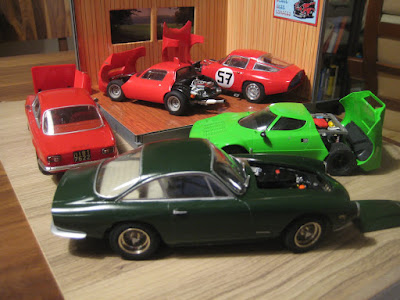

My modeling skills have improved since 2013, partly through building several dozen increasingly detailed styrene and resin kits, and partly through determination to get the MFH kits to the level of finish they deserve. It has been, and continues to be a learning experience, and I would like to share the results of that learning next.
After starting the 908/03 and shelving it in frustration the first time, the first MFH kit I finished was the Abarth OT 1300 Periscopio, one of the so-called Proportion Kit series that have less detail than the Full Detail series. It worked out well, in large part because it was a lot simpler. Probably the biggest worry was cutting the vacuum-formed glass too fine. I have not seen this kit in the MFH catalog or on eBay for some time; the Proportion kits available seem to be largely Ferrari 488 GTE's and Aston Martin DBR9's.



In an act of bravery or foolhardiness, the second MFH kit I tackled was the 1/43 BRM H16. A fascinating little car with an oddball engine (a pair of flat 8s, stacked one above the other and geared together), it went together well given that everything was assembled under my 4X desktop magnifying glass. I would not recommend starting here, however ... the drawing of the engine in the instruction sheet is actually bigger than the actual 1/43 engine. And I wore out my 0.020" (0.5mm) drill. Finally I had a scare when I thought I had lost the steering wheel; my first reaction was not to worry as I have lots of spare steering wheels in the parts bins, but then I recalled they are all 1/24 or 1/25! Fortunately it resurfaced.



The Ferrari 250 GT Lusso went together very well as the chassis is a solid slab of white metal. Other Ferraris of this vintage, as well as the Cobra Daytona, are similar. Here the detail level is entirely due to my own decisions as to what is 'good enough'. The little jig for the grille was critical, and the wheels, while finicky, are gorgeous.




Most recently I finished up the Alfa Romeo TZ1. The major issue here was that I cut down the vacuum-formed windshield a little too far ... in any case I am quite happy with this one, and the frame here is a space frame which went together a lot better than the 908/03. Experience or kit design? A little of both, I suspect.




So there you have it -- a beginners guide to MFH. Don't panic, they are wonderful kits, but be realistic about your skill level before tackling one. Little, flexible struts made of spun-cast white metal do not lend themselves easily to dimensional stability.

So: you should DEFINITELY tackle an MFH kit, but you MUST start with an honest assessment of your skill level and willingness to be patient. Accept that perfection comes with practice. I intend to build more, and I intend for each build to be better than the last. Stay tuned!
No comments:
Post a Comment